Menu
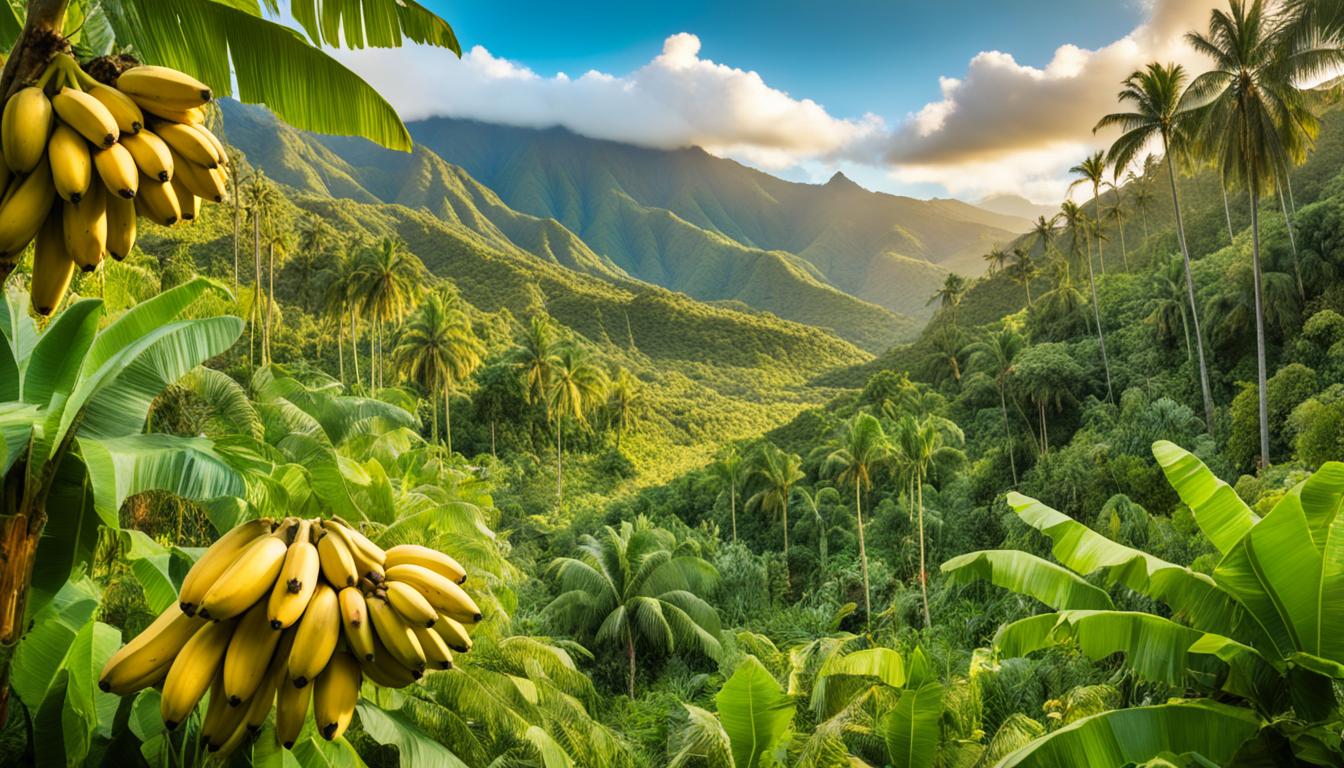
Did you know Costa Rica has upped its forest cover to 52%? This surge comes from regenerating seven times more trees than it cuts. It shows the country’s focus on sustainable farming and saving plants and animals. There’s a cool way Costa Rica is using called food forest systems. They help farm the land in a way that looks after the environment and makes sure there’s enough food for everyone.
People from everywhere, like Ian from Ohio, have joined in to help. Ian learned a lot about living in harmony with nature from other cultures. In Costa Rica, he combines all this to help design places that use nature smartly. His know-how in city planning and growing food without hurting the earth is a big help. He’s really passionate about this style of farming called permaculture, which he learned from a top expert in Australia, Geoff Lawton.
Food forest systems blend permaculture with ecological landscaping. They show how nature creates ecosystems that can sustain themselves. These systems go beyond growing food. They form a living ecosystem where various plants support each other.
Food forests use the concept of layers. Just like in a forest, there are tall trees, smaller shrubs, and herbs on the ground. This design, called polyculture, produces more food and fights off pests without chemicals. It’s a key part of organic permaculture, which focuses on growing plants naturally.
Food forests combine ancient farming with modern permaculture. Old farming methods taught people to work with nature. Today, we use science to make these methods even better. This mix of history and science is the heart of food forest systems.
John Valenzuela is a big name in this area, living and teaching in Hawai’i and Costa Rica. His work shows the power of food forests in modern farming. Courses at the Bullock Family Homestead in Washington share his knowledge widely.
In Costa Rica, food forests are a model of sustainable farming. These gardens include plants for food, medicine, and beauty, following nature’s example. They need little care but offer lots of food all year. This approach suggests a way for farming to be kind to the earth and people.
Breaking down a garden into layers makes it a thriving, balanced space. This way of gardening, inspired by nature, is changing farms worldwide. By mimicking natural ecosystems, food forests are more than places to grow food. They are a symbol of how we can live in harmony with the planet.
Permaculture design in Costa Rica has really boosted tropical agroforestry and regenerative farming. The environment’s diversity and ideal conditions are perfect for these methods. Thanks to the hard work of pioneers, like Geoff Lawton, these practices have grown.
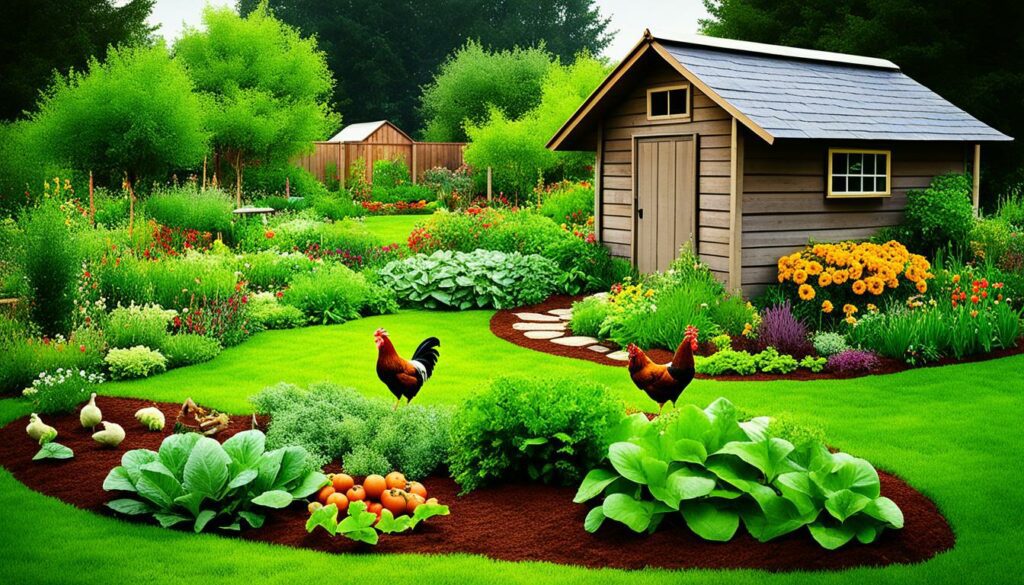
In Costa Rica, pioneers have changed the game with regenerative farming and agroforestry. Through years of effort, they’ve created rich, self-sustaining environments. Punta Mona stands out, with a food forest of 300+ fruits, nuts, roots, and more. This shows how much their work impacts sustainable farming.
Geoff Lawton’s teachings are key for Costa Rica’s progress in permaculture. He helps with regenerative farming and agroforestry, as seen at Finca Tierra Permaculture. This centre has been running for 10 years, welcoming students worldwide. They learn practical skills in the mornings and discuss wider applications in the afternoons. Each student designs their 1-acre homestead, spreading sustainable farming ideas.
Lawton’s impact includes smart water use in places like Guanacaste. They use methods like rainwater collection and swales for better water management. These techniques boost crop growth, even in tough spots.
Thanks to pioneers and Lawton’s guidance, Costa Rica is moving towards a greener, more sustainable future.
Costa Rica shines as a model for green farming, blending eco-efforts with strong agricultural methods. The Ministries of Agriculture (MAG) and Environment (MINAE) work closely to boost organic permaculture and farming that helps the land. They’ve formed an Agro-environmental Agenda that mixes economic, social, and green goals.
At the heart of Costa Rica’s farming feats are its green guidelines. It focuses deeply on organic permaculture, seen in projects like the Finca Paraíso Orgánico. This 33-hectare farm shows how farming can be organic and productive. They use smart methods like composting and managing pests with nature to keep the soil healthy.
Costa Rica deeply values regenerative farming to heal the land and bring back diverse plants and animals. The World Bank’s PROGREEN helps to spread green farming, making big impacts. Projects to grow climate-smart coffee and help livestock, alongside tests with sugar cane and rice, move Costa Rica towards its green goals.
Food sovereignty is key in Costa Rica’s farming plan. It means that local areas control and support their food systems, which boosts their independence and helps villages grow. Efforts focused on placing goods in international markets work for saving the environment and fight rural poverty, which can be high.
Costa Rica protects about 30% of its land, with half under forest cover, showing its care for its nature. The PROGREEN aid supports efforts to treat the land well, using high tech to watch over environmental services.
Working together, institutions and the people in Costa Rica prove their strong eco-focus. Their Green Growth Program wants to change 200 smaller companies into green heroes. This will push healthy foods, like organics and superfoods, into many markets, helping local needs and global green targets.
These moves don’t just aid local food goals but also make sure farming in Costa Rica is both profitable and friendly to our planet. It finds a sweet spot between what locals need and what our world needs for a green tomorrow.
Organic permaculture in Costa Rica provides a strong model for sustainable farming. It uses many methods to build food forests that can support themselves. We’ll look at how these practices work and some stories that show their success.
Costa Rica’s organic permaculture fits well with nature. It uses things like:
Many farms in Costa Rica prove that these ideas really work, especially in the warm, rainy climate.
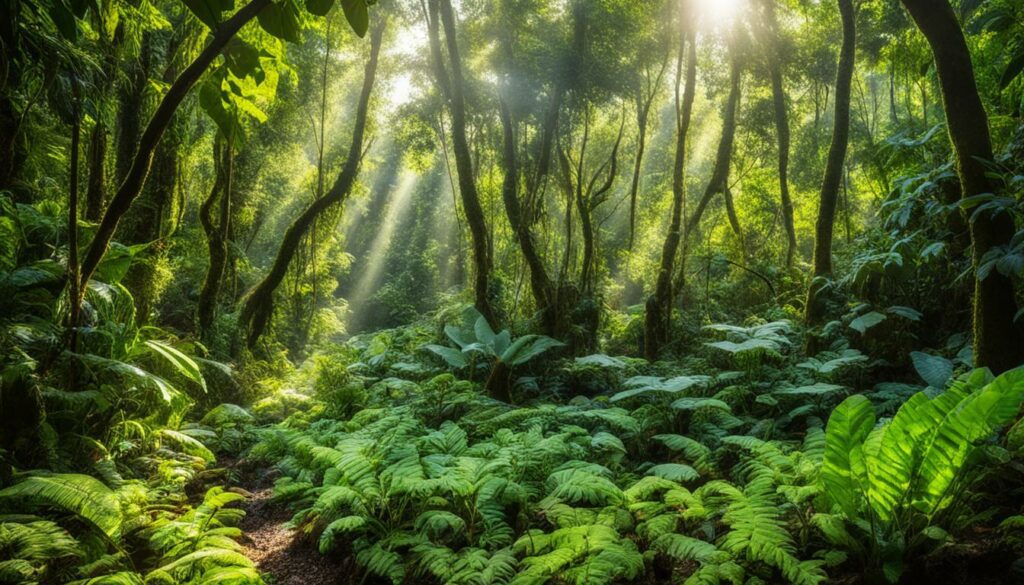
For example, Finca Tierra is a key place where many people have learnt about permaculture for more than ten years. It runs a 72-hour course over three weeks at times in the year. This course costs $1,850.
They teach useful skills like how to use tools, clear land, know plants, and plant trees. People stay in bamboo houses and eat food from the farm. The course includes visiting a native healer, showing how permaculture joins with local ways in Costa Rica.
| Course Duration | Price | Start Dates |
|---|---|---|
| 72 hours | From $1,850 | March 10, September 8, November 3, 2024 |
| Skills Covered | Accommodation | Meals |
| Blade and Knife Sharpening, Land Clearing, Plant Identification, Food Forest Fundamentals | Bamboo Cabinas (Private/Shared) | Farm-to-Table |
In Costa Rica, using tropical agroforestry methods is key to long-term land use success. These techniques mix forestry with farming, old and new. They help save wildlife and make land healthier.
Shade-grown coffee is a big part of this. It keeps the soil damp, offers animals a home, and saves plant and animal types. Multilayer cropping looks like a forest, with plants at different heights. This uses sunlight and soil best.
These ways also make the soil better, stopping it from washing away. Adding trees that pull in nitrogen improves soil over time, helping crops grow more.
Costa Rican farms show these methods really work. At Finca Tierra, they mix growing plants and raising animals, making a strong farm. Shade-grown coffee there is top quality and helps many species live, proving caring for nature works well.
| Farm | Technique | Impact |
|---|---|---|
| Finca Tierra | Shade-grown coffee | Enhanced biodiversity conservation, improved soil health |
| Selva Armonia | Multilayered cropping | Optimised land use, boosted crop yield |
| Rancho Mastatal | Nitrogen-fixing trees | Improved soil fertility, reduced erosion |
These farms show how blending forests with farms is a win-win. It helps the earth and the food we grow, making farming last and be healthy.
Food sovereignty movements in Costa Rica fight for communities’ rights to manage their food. People work together to make sure farming fits local needs and traditions. A big win is that 92% of Costa Rica’s cantons don’t allow GMOs, protecting food sovereignty. Supporters push for clear labels so people know if products contain genetically modified items.

Costa Rica fights back through different projects. These include saving and sharing older seeds, growing things organically, and setting up group certifications. In the north, people have turned old farm areas into natural spaces, planting rare trees and herbs. These local efforts are key to keeping agriculture eco-friendly and diverse.
There’s been a big drop in growing old foods and more people leaving the land. This shows we really need food sovereignty programmes. Costa Rica is moving towards eco-friendly farming with the help of local communities and their wisdom. These groups are fighting the loss of plant and animal species from big agriculture. They’re also helping to cut down on harmful gases and save the environment.
Costa Rica works hard to balance farming with nature protection. It uses laws and new ways to manage the land to keep its many ecosystems safe.
The country is home to about 6% of Earth’s species because of its varied environments and strong conservation work. Over a third of Costa Rica’s land is protected, making a safe home for many plants and animals. Since 1987, reforestation has increased forest areas from 21% to 59% today, improving living spaces for its wildlife.
Costa Rica uses food forest systems to grow sustainably while helping local wildlife. Such systems, along with ecological landscaping, make places where both food and wild plants can grow well. This mix of cultivated and natural plants invites many animals to thrive.
| Statistic | Value |
|---|---|
| Forest Cover | 59% |
| Protected Land | 35% |
| Electricity from Renewable Sources | 95-98% |
| Biodiversity Hosting | 6% of world’s species |
| Indigenous Population | 1% |
Costa Rica uses the Biodiversity Law to get everyone involved in saving its nature. This law mixes new rules with old ways of protecting nature. By joining these, Costa Rica aims to be the first carbon-neutral country by 2050.
Yet, there are still challenges. Coastal areas, for example, face risks and pollution. But Costa Rica’s approach, which includes food forest systems in its farming and nature care, shines as an example of how to protect our planet.
Costa Rica’s agriculture is evolving, focusing on regenerative farming. This means they grow food while also restoring the land. They look after the soil, water, and the variety of plants and animals that live there.
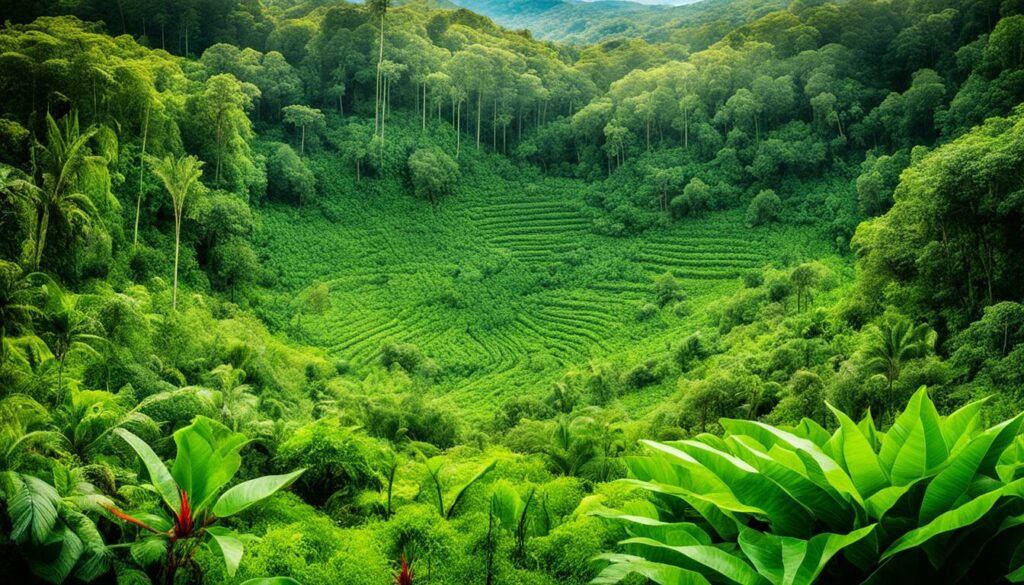
Regenerative farming uses smart techniques to help the soil thrive. For example, they add organic matter and switch the kinds of plants they grow. This keeps the soil healthy, making it good for growing food.
They also find ways to keep rainwater to use for the crops. By shaping the land in a certain way, they can store rainwater in the ground. This not only helps their plants but also saves water for the future.
Another strategy is growing a wide variety of crops together, like in a forest. This makes the whole area stronger against problems like pests. In Costa Rica, they have forests full of fruit trees, with a huge range of different kinds.
In Costa Rica, impressive examples of these farming methods show the way forward. They have gardens that produce a lot of food using sustainable practices. These gardens prove that it’s possible to farm in a way that’s good for the land and for people.
They don’t use harmful chemicals on their crops. Instead, they use natural ways to keep the land clean. For example, they use certain fungi that help the soil get rid of dangerous chemicals. This way, their farms are safe and healthy for everyone.
| Key Elements | Implementation |
|---|---|
| Soil Regeneration | Use of organic materials and crop rotations |
| Water Conservation | Contour swales for effective rainwater storage |
| Crop Diversity | Integration of over 130 varieties of fruit trees |
| Toxin Clean-up | Mycoremediation with fungi |
| Biodiversity Preservation | Living seed bank with over 500 plant types |
| Sustainable Food Production | Annual production of tons of diverse food produce |
The Punta Mona Centre is in Costa Rica, on an 85-acre site without the grid. It shows how to live sustainably blending with the local nature. It uses 35 acres for growing food but keeps 50 as a natural forest, showing its care for biodiversity conservation.
The Centre is a leader in growing different plants. It has more than 200 plants you can eat, thanks to the warm weather and careful planning. These include fruit trees and others that help not only with food but also protect wildlife.
Besides its amazing plants, The Punta Mona Centre helps people learn about farming in a way that helps the Earth, too. It offers classes on topics like starting a garden, making use of herbs, and calming practices. It aims to share skills that can be used anywhere to support food forest systems and protect biodiversity.
| Feature | Attribute |
|---|---|
| Land Usage | 35 acres cultivated, 50 acres forest habitat |
| Water System | Gravity-fed water-catchment, 2 wells, purification system |
| Energy Source | Solar power |
| Composting Toilets | 12 dry composting toilets |
| Waste Management | Minimal waste production, repurposing items |
| Educational Courses | Permaculture, Herbalism, Fermentation, Yoga |
The Punta Mona Centre is a model of living sustainably, using the latest farming methods and teaching others. By caring for special plants and educating people, it’s a leader in food forest systems Costa Rica and biodiversity conservation.
In Costa Rica, edible gardens mix beauty with functionality. These gardens grow fruits, such as pineapples, bananas, and oranges. They make the environment more attractive and help ensure there is enough food locally.
Every year, these gardens produce over 5,000 kilos of mangoes. Their variety goes beyond fruits, with plants like turmeric and ginger. This wide range supports communities in growing their own fresh, healthy food.
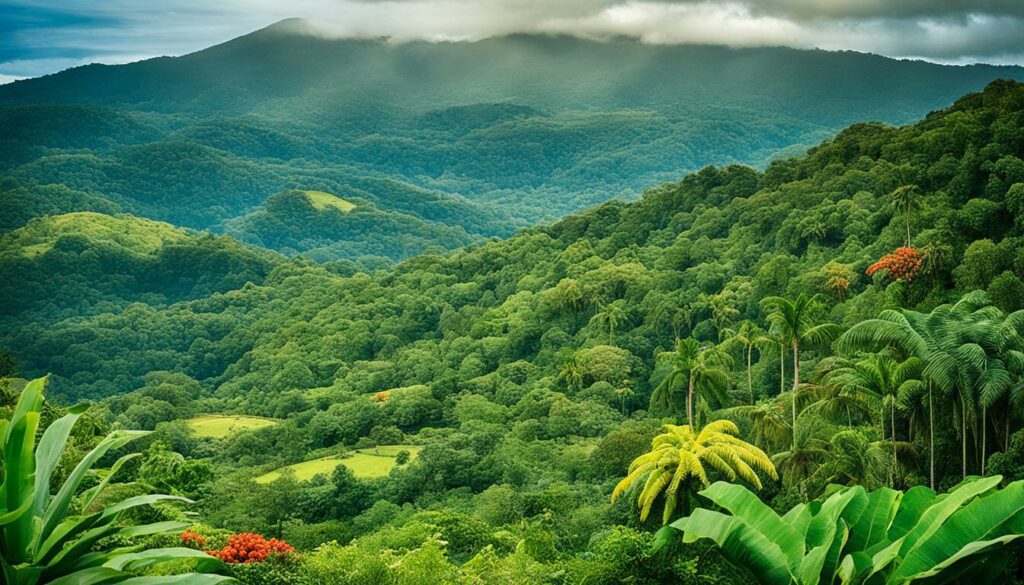
Costa Rica also protects its plants through a living seed bank. It has over 500 plant types, including some that are very rare. By doing this, Costa Rica helps keep its plant life diverse and its food system strong.
The variety in these gardens is amazing. They grow things like yuca, moringa, and spinach. All this shows how diverse and plentiful edible gardens can be. They help keep food local and the environment healthy.
In tropical farming systems, fruit trees and perennials are key. They help grow food and keep the environment healthy. These plants give food all the time and make the area more diverse. They help in many ways, like keeping the soil good and helping animals find homes.
The Jesús María River Basin is a great example of how this works. Although once very damaged, it’s getting better thanks to projects like COMDEKS. They’ve planted around 54,000 trees, with many being fruit trees, such as mango and avocado. These trees are not only for food. They also help by giving shade, making the soil better, and supporting wildlife.
Having fruits all year is very important in these systems. Trees like mangosteen and jackfruit provide food when others can’t. This mix of fruits helps make sure there’s always enough to eat. It also makes sure the farming area is strong all year round.
These trees and plants are also used where animals graze, as seen in COMDEKS projects. They’ve made 150 stables and other areas for animals to eat. This makes the land more useful and helps take care of the animals and the trees.
| Species | Characteristics | Harvest Season | Economic Value |
|---|---|---|---|
| Mango | High yield, drought-resistant | Summer | High |
| Cashew | Resilient, nutritious nuts | Spring | Moderate |
| Loquat | Early bearing, versatile | Winter | Medium |
| Avocado | Rich flavour, numerous varieties | Year-round | High |
| Mangosteen | Exotic, nutrient-dense | Late Summer | High |
| Jackfruit | Largest tree-borne fruit, versatile use | Year-round | High |
| Breadfruit | Staple food, high yield | Year-round | Medium |
Innovative food production methods are key to sustainable farming. Costa Rica leads with two standout approaches: Hügel beds and mushroom growing.
Hügel beds mix decaying wood with other compost material in raised beds. They boost soil quality, water retention, and oxygen levels. This lowers the need for harmful chemicals and saves water.
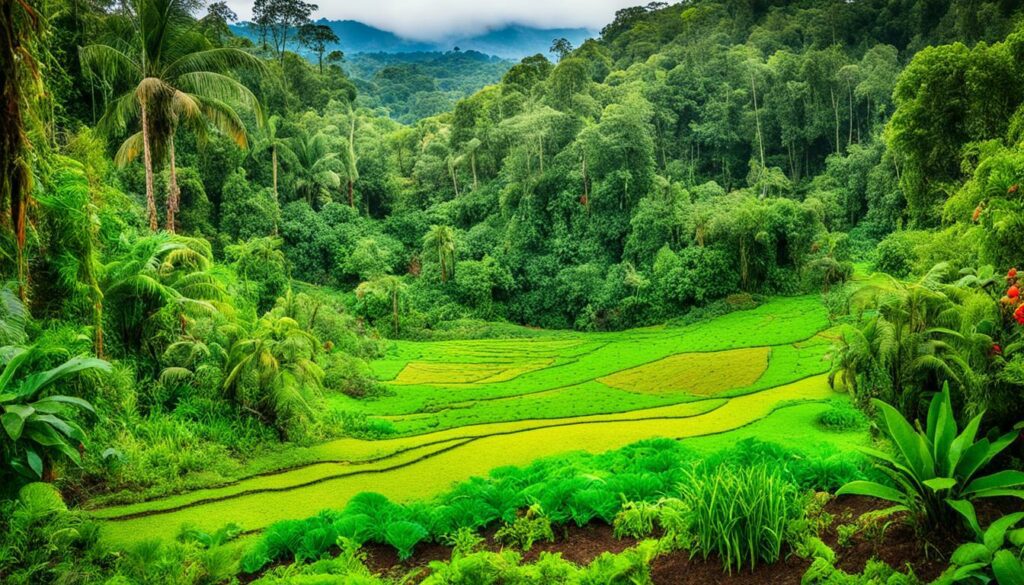
Costa Rica’s perfect climate has made it great for growing mushrooms. This doesn’t just add nutrition but also income. Also, growing mushrooms uses farm waste, which helps the earth and boosts plant health.
Hügel beds and growing mushrooms are part of Costa Rica’s sustainable approach. They show that careful farming can help the Earth a lot. This way of farming helps now and protects the future.
Costa Rica’s food forest systems face many challenges. These include trouble with managing land and dealing with changing climates. Developing solutions to these obstacles is crucial for these systems’ ongoing achievements.
Costa Rica struggles with several key problems in its agriculture. There’s not always enough money for things like the National Forest Inventories (NFIs). Plus, the climate can be unpredictable. In 1984, over half of Costa Rica’s land was used for farming. By 2013, this dropped to just over a third. Such changes show how land use is evolving, which can push food production to its limits.
Although Costa Rica’s forest area grew to 51% by 2010, managing these forests alongside farming is hard. Only a tiny percentage of farmland, 1.54%, can be irrigated. This adds another layer of complexity.
To overcome the challenges, many sustainable solutions are available. Encouraging the local community to get involved through education and management is vital. This ensures that locals are at the forefront of maintaining food forests. It also helps adapt these systems to changes quickly.
It’s also crucial to get steady, long-term funding for NFIs. The government’s support in running these surveys is key. It helps keep up the good work in saving biodiversity and tracking soil health. A table below compares challenges and their solutions in more detail.
| Challenge | Sustainable Solution |
|---|---|
| Land management issues | Community engagement and education |
| Climate variability | Adaptive management strategies |
| Inconsistent NFI funding | Secured long-term governmental funding |
| Limited irrigation | Optimised resource allocation |
Although the hurdles in creating food forests in Costa Rica are big, well-aimed, and well-supported actions can bring about real success.
Community involvement is key to the vibrant food forest systems in Costa Rica. This is essential for their success and importance in the culture. The country welcomes around 2.5 million visitors yearly, mainly from wealthy nations. They bring with them various food cultures that influence local meals and economy. Despite this, it’s vital for the community to control their food’s making and sharing, called food sovereignty.
Where I work, we get food from our local farms to keep our meals as Costa Rican as possible. By doing this, we reduce the urge to use foreign foods. It’s not easy to find a balance between being practical and having fun, all while supporting local food. We aim to get both tourists and locals to appreciate Costa Rica’s special food traditions. This is important for our food culture’s future.
In the Talamanca area, most cocoa growers are women who own the land. This shows how women play a big part not just in farming but also in community strength. The Bribri’s farming system involves many trees that give wood, fruits, and medicine. Over 30 tree types are part of their lives and work. With ACOMUITA, a group focused on cocoa work, 89 women show how essential women are for farming and saving their culture.
Costa Rica faces challenges from big agriculture and heavy pesticide use, but its people are dedicated to a different path. They are focused on maintaining their food independence and culture. By backing local food forests, we help keep these traditions alive. This effort benefits both the people and Costa Rica’s economy. The effort from everyone in the community, along with their cultural pride, is the key to a sustainable future in farming.
Food forest systems use layers of vegetation like natural forests. In Costa Rica, they are key to farming while keeping the ecosystem safe.
Food forests started with indigenous ways of living with nature. They mix old and new farming methods to build strong ecosystems, like in Costa Rica.
Ian has mixed his skills to boost permaculture in Costa Rica. He uses what he learned about farms and cities to grow new, sustainable ways.
Agriculture in Costa Rica values nature, organic methods, and the bond between people and the land. Organic permaculture and regenerative farming are key.
Organic permaculture in Costa Rica uses composting, planting different crops together, and natural ways to fight off pests. These ways aim to sustain farms on their own.
Many farms in Costa Rica are successful examples of permaculture. For instance, Finca Luna Nueva proves permaculture works well in the tropics.
Tropical agroforestry in Costa Rica uses methods such as growing coffee in the shade and multiple crops. This helps the ground stay healthy and protects many types of plants and animals.
The food sovereignty movement looks to give Costa Rica control over its food from start to end. It values local ways of farming, what native people know, and friendly methods for the earth.
Protecting biodiversity in Costa Rica means giving home to local plants and animals. This connects farming with saving wild species.
Regenerative farming in Costa Rica focuses on making soil and water better and growing many types of crops. This helps soil be rich, stops land from washing away, and makes farming stronger against bad weather.
The Punta Mona Centre grows special plants and teaches good ways to farm. It’s a leading example of farming while keeping a lot of kinds of plants and animals alive.
Edible landscapes make beautiful gardens that feed people, too. They make cities nicer and support living together with the planet in Costa Rica.
Fruit trees and perennials are a big part of farming in Costa Rica. They include trees like mangosteen, jackfruit, and breadfruit that give food all year, making sure there’s plenty to eat.
In Costa Rica, they use Hügel beds and grow mushrooms in new ways. These methods enrich the earth, help many plants and animals live together, and find new types of food.
Making food forest systems in Costa Rica faces hard issues with land and the weather. Working together, always learning, and being ready for change can solve these problems.
Working together in Costa Rica is key to making food forest systems work well and keep going. It shows the strong link between the ways of the land and its people.